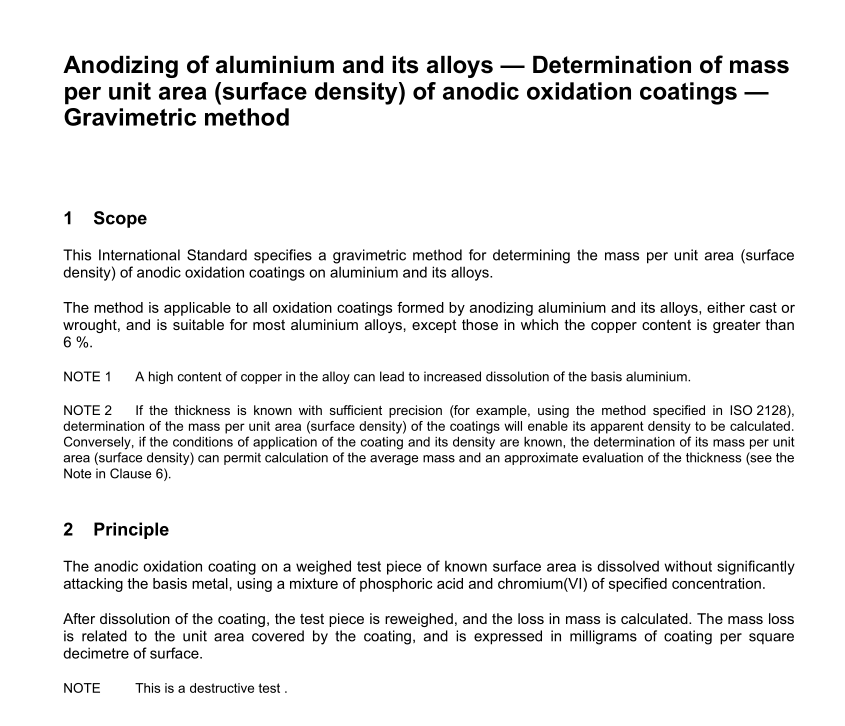ISO 2106 pdf download

ISO 2106 pdf download Anodizing of aluminium and its alloys — Determination of mass per unit area (surface density) of anodic oxidation coatings — Gravimetric method
1 Scope
This International Standard specifies a gravimetric method for determining the mass per unit area (surfacedensity) of anodic oxidation coatings on aluminium and its alloys.
The method is applicable to all oxidation coatings formed by anodizing aluminium and its alloys,either cast orwrought, and is suitable for most aluminium alloys, except those in which the copper content is greater than6%.
NOTE1 A high content of copper in the alloy can lead to increased dissolution of the basis aluminium.
NOTE2 lf the thickness is known with sufficient precision (for example,using the method specified in lSo 2128),determination of the mass per unit area (surface density) of the coatings will enable its apparent density to be calculated.Conversely, if the conditions of application of the coating and its density are known, the determination of its mass per unitarea (surface density) can permit calculation of the average mass and an approximate evaluation of the thickness (see theNote in Clause 6)-
2Principle
The anodic oxidation coating on a weighed test piece of known surface area is dissolved without significantlyattacking the basis metal, using a mixture of phosphoric acid and chromium(Vl) of specified concentration.
After dissolution of the coating, the test piece is reweighed, and the loss in mass is calculated.The mass lossis related to the unit area covered by the coating, and is expressed in milligrams of coating per squaredecimetre of surface.
NOTE This is a destructive test .
Reagent
Use only reagents of recognized analytical grade and only distilled water or deionized water.3.1 Phosphoric acid/chromic solution, prepared as follows:
– phosphoric acid,p2o0= 1,7 g/ml: 35 ml;
—chromium(Vl) oxide:
20 g;
-water:
make up to 1 000 ml.
WARNING- Chromium(V) is toxic and shall be handled properly. Chromium(Vi) solutions arehazardous to the environment and severely hazardous to waters.
4Apparatus
Usual laboratory apparatus and glassware, together with the following.4.1 Laboratory balance, capable of weighing to an accuracy of 0,1 mg.
5 Procedure
5.1 Preparation of test piece
The surface of the test piece to be tested shall have an area of between 0,08 dm2 and 1 dm2, and the mass ofthe test piece shall not exceed 100 g. lf the surface is dirty or impregnated with oil, grease or similar material,this shall be removed with the aid of a suitable organic solvent (see Annex A).
To measure the mass of the coating on one surface only of the test piece, the coating on the other surfaceshall be removed by a mechanical or chemical process,leaving the significant surface intact. Alternatively, aprotective agent, resistant to attack by the acidic test solution, shall be applied on the reverse surface of thetest piece.
5.2Performance of the test
Calculate the area of the surface covered by an anodic oxidation coating, weigh the test piece to the nearest0,1 mg and immerse it in the phosphoric acid/chromic solution (see 3.1) for 10 min, at 95 C to 100 °C, withefficient stirring. Rinse the test piece in water, dry and reweigh it (see Annex A).Repeat the immersion, dryingand weighing until no further loss in mass is observed.
NOTE The freshly made reagent will normally allow complete dissolution of the coating within 10 min. lts dissolvingpower diminishes with use; in general,1l of solution is capable of dissoving 12 g of coating before the diminutionbecomes noticeable.
6 Expression of results
Calculate the mass per unit area of surface (surface density) of the coating pA, in milligrams per squaredecimetre, using Equation (1):
where
mis the mass, in milligrams, of the test piece before dissolution of the coating;m2is the mass, in milligrams, of the test piece after dissolution of the coating;
Ais the area, in square decimetres, effectively covered by the coating of which the mass is measured
(without taking into account edges or other uncoated parts).
NOTE Where required,the average thickness of the coating,,in micrometres, can be estimated,usingEquation (2y:
where
ρ A is the mass per unit area (surface density), in milligrams per square decimetre, of the coating;
ρ is the density, in grams per cubic centimetre, of the coating.









